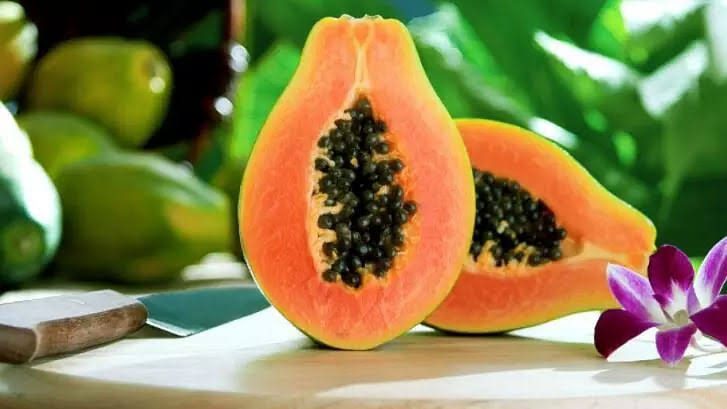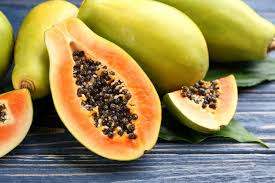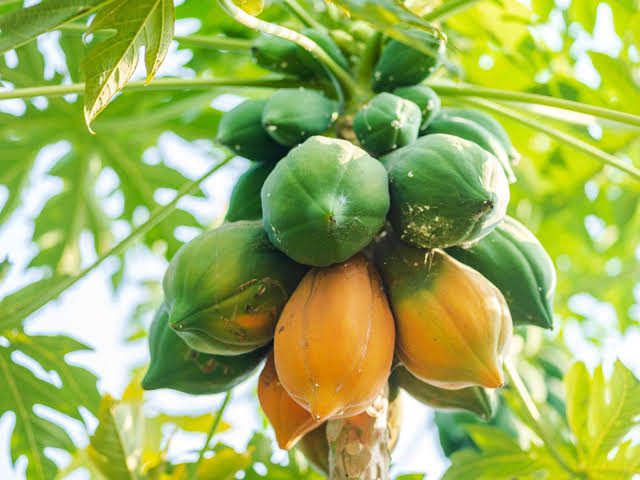Papayas fruit which is scientifically known as Carica papaya are tropical fruits that grow on large, herbaceous plants. These fruits are not only delicious but also packed with essential nutrients that contribute to a healthy lifestyle. With their vibrant orange color and sweet taste, papayas are a popular choice for both culinary and nutritional purposes.
The papaya tree, scientifically known as Carica papaya, is native to Central America and Mexico, but it is now cultivated in many tropical and subtropical regions around the world. The fruit itself is typically pear-shaped and can vary in size, with the average papaya weighing around one to two pounds.
One of the standout features of papayas is their rich content of vitamin C, a powerful antioxidant that supports the immune system. Consuming papayas regularly can contribute to overall well-being and help the body defend against illnesses. Additionally, papayas contain other essential vitamins and minerals, such as vitamin A, vitamin E, and folate, making them a nutritious addition to a balanced diet.
The unique enzyme called papain, found in papayas, aids in digestion by breaking down proteins. This makes papayas not only a delightful treat for the taste buds but also a digestive aid that can promote a healthy gut. Some people even use papaya supplements or papaya-based digestive enzymes to support digestive health.
Beyond their nutritional benefits, papayas are versatile in the kitchen. They can be enjoyed in various ways, from simply scooping out the seeds and eating the flesh to incorporating them into fruit salads, smoothies, or even savory dishes. The natural sweetness of papayas makes them a refreshing addition to desserts, and their juicy texture adds a delightful element to any culinary creation.
In many cultures, papayas are celebrated not only for their taste but also for their potential health benefits. Some traditional medicinal practices even use different parts of the papaya plant for their perceived healing properties. While scientific research continues to explore the full extent of papaya’s health benefits, there is no doubt that incorporating this tropical fruit into your diet can be a tasty and nutritious choice.
In addition, papayas are more than just a delightful tropical fruit – they are a nutritional powerhouse. Packed with essential vitamins, minerals, and antioxidants, papayas offer a range of health benefits, from supporting the immune system to aiding digestion. Whether enjoyed fresh or used in various culinary creations, papayas are a delicious and versatile addition to a healthy lifestyle.
Read Also: The Potentials and Constraints to Pig Production in Developing Countries
The History of Papayas (Carica papaya)

The history of papayas traces back to their origins in Central America and Mexico, where the indigenous peoples cultivated and appreciated these tropical fruits for centuries. The scientific name, Carica papaya, reflects the plant’s classification within the Caricaceae family.
It is believed that Spanish explorers encountered papayas during their voyages to the Americas in the 16th century. The explorers were captivated by the unique flavor and vibrant color of the fruit, leading to its introduction to other parts of the world.
Over time, papayas found their way to various tropical and subtropical regions, adapting well to the climatic conditions of places like Asia, Africa, and the Caribbean. The cultivation of papayas expanded, and the fruit became a staple in many diets due to its delicious taste and nutritional value.
In addition to being a culinary delight, papayas gained recognition for their potential medicinal properties. The enzyme papain, present in the fruit, was noted for its digestive benefits, and various cultures incorporated papayas into traditional remedies for digestive issues.
The commercial cultivation of papayas increased in the 20th century, with countries like Brazil, India, and Indonesia becoming major producers. The demand for papayas grew globally, as people recognized not only their unique flavor but also their contribution to a balanced and nutritious diet.
As papayas became more widely available, they found their way into international cuisines, adding a tropical touch to a variety of dishes. Today, papayas are enjoyed across the globe, both for their delightful taste and their potential health benefits.
The history of papayas reflects a journey from their indigenous roots in Central America to becoming a globally cherished fruit. From their discovery by Spanish explorers to their widespread cultivation and integration into diverse cultures, papayas have left a flavorful and nutritious mark on the world’s culinary landscape.
Nutritional Value of Papayas (Carica papaya)

Papayas boast an impressive nutritional profile, offering a range of essential vitamins, minerals, and antioxidants. Here’s a glimpse into the key nutritional components of this tropical fruit:
1. Vitamin C: Papayas are rich in vitamin C, an antioxidant that plays a crucial role in supporting the immune system. Adequate vitamin C intake is essential for overall health and can contribute to the body’s ability to fend off infections.
2. Vitamin A: Papayas are a good source of vitamin A, which is vital for maintaining healthy skin, vision, and immune function. The presence of beta-carotene, a precursor to vitamin A, gives papayas their vibrant orange color.
3. Folate: Folate, a B-vitamin, is present in papayas and is important for cell division and DNA synthesis. Adequate folate intake is particularly crucial during pregnancy for proper fetal development.
4. Vitamin E: Papayas contain vitamin E, another antioxidant that helps protect cells from damage. This vitamin plays a role in skin health and overall well-being.
5. Fiber: Papayas provide dietary fiber, aiding in digestion and promoting a healthy digestive system. Fiber is also beneficial for maintaining a feeling of fullness, which can support weight management.
6. Papain: This natural enzyme found in papayas, particularly in the latex of unripe fruits, aids in the digestion of proteins. Papain is sometimes used as a meat tenderizer and is also found in digestive enzyme supplements.
7. Minerals: Papayas contain essential minerals such as potassium, magnesium, and copper. Potassium is important for maintaining proper fluid balance, heart health, and muscle function.
8. Antioxidants: Beyond specific vitamins, papayas contain various antioxidants that help combat oxidative stress in the body. Antioxidants play a role in reducing the risk of chronic diseases and supporting overall health.
Incorporating papayas into your diet can be a delicious way to boost your intake of these essential nutrients. Whether enjoyed fresh, in smoothies, fruit salads, or as part of various dishes, papayas offer a tropical and nutritious addition to a well-balanced diet.
Read Also: Principles of Pig Production for Optimum Performance
Health Benefits of Papayas (Carica papaya)

Papayas offer a range of health benefits due to their nutrient-rich composition. Here are some of the potential positive impacts of including papayas in your diet:
1. Immune Support: The high vitamin C content in papayas can help boost the immune system, contributing to the body’s ability to defend against infections and illnesses.
2. Digestive Health: The enzyme papain in papayas aids in the digestion of proteins, promoting a healthy digestive system. Consuming papayas may help alleviate digestive issues and enhance nutrient absorption.
3. Skin Health: The combination of vitamins A, C, and E in papayas contributes to healthy skin. These antioxidants help protect the skin from damage caused by free radicals, potentially reducing signs of aging.
4. Eye Health: The beta-carotene in papayas is converted to vitamin A in the body, supporting good vision and overall eye health. Adequate vitamin A intake is essential for maintaining proper eyesight.
5. Heart Health: The potassium in papayas is beneficial for heart health, helping regulate blood pressure and supporting cardiovascular function. Additionally, the fiber content may contribute to lower cholesterol levels.
6. Anti-Inflammatory Properties: Some compounds in papayas have been studied for their potential anti-inflammatory effects. A diet rich in anti-inflammatory foods may help reduce the risk of chronic diseases.
7. Weight Management: The fiber content in papayas contributes to a feeling of fullness, potentially aiding in weight management by reducing overall calorie intake.
8. Hydration: With a high water content, papayas can contribute to overall hydration, supporting various bodily functions and promoting healthy skin.
9. Bone Health: The presence of minerals like calcium and magnesium in papayas is beneficial for maintaining strong and healthy bones.
10. Reduced Risk of Chronic Diseases: The antioxidants and other beneficial compounds in papayas may contribute to a lower risk of chronic diseases, including certain types of cancer.
It’s important to note that while papayas offer these potential health benefits, they are just one component of a balanced diet and a healthy lifestyle. Individual responses to dietary changes can vary, and it’s always advisable to consult with a healthcare professional for personalized advice.
How to Grow Papayas (Growing Guide)
Growing papayas requires a warm and tropical climate, but if you’re in the right region, here’s a basic guide to cultivating these tropical fruits:
1. Climate: Papayas thrive in tropical and subtropical climates with temperatures between 70°F to 90°F (21°C to 32°C). They are sensitive to frost and grow best in areas with a consistent warm temperature.
2. Soil: Papayas prefer well-draining soil rich in organic matter. A slightly acidic to neutral pH level (6.0-7.0) is ideal for optimal growth. Sandy loam or loamy soil types are generally suitable.
3. Planting: Choose a sunny location that receives at least 6 hours of sunlight daily.
Plant papaya seeds directly in the ground or start with seedlings. Ensure a spacing of about 8 to 10 feet between plants to allow for their expansive growth. Plant seeds or seedlings at a depth of around 1 inch (2.5 cm) in the soil.
4. Watering: Papayas require regular watering, especially during dry periods. Keep the soil consistently moist but not waterlogged. Mulching around the base helps retain moisture.
5. Fertilizing: Use a balanced, slow-release fertilizer containing micronutrients. Apply fertilizer every 2-3 months during the growing season. Avoid excessive nitrogen, as it can lead to tall, weak plants.
6. Pruning: Remove dead or damaged leaves regularly. Prune overcrowded areas to promote better air circulation and sunlight penetration. This helps prevent diseases and ensures healthy growth.
7. Support: Young papaya plants may need support to prevent them from toppling over in strong winds. Staking can provide stability until the plant establishes a strong root system.
8. Pest and Disease Control: Keep an eye out for pests like aphids and mites. Insecticidal soap or neem oil can be used for natural pest control. Ensure good airflow to prevent fungal diseases.
9. Harvesting: Papayas usually start producing fruit within 6 to 11 months after planting. Harvest when the skin begins to turn yellow and the fruit feels slightly soft to the touch. Use pruning shears to cut the fruit from the tree.
10. Ripening: Papayas can continue to ripen after harvest. Place them at room temperature until they reach the desired ripeness. Refrigeration can slow down ripening if needed.
Remember that the specific requirements for growing papayas can vary based on your local climate and soil conditions. If you’re new to papaya cultivation, local gardening experts or agricultural extension services can provide valuable insights tailored to your region.
Read Also: How To Fix a Garbage Disposal Jam
